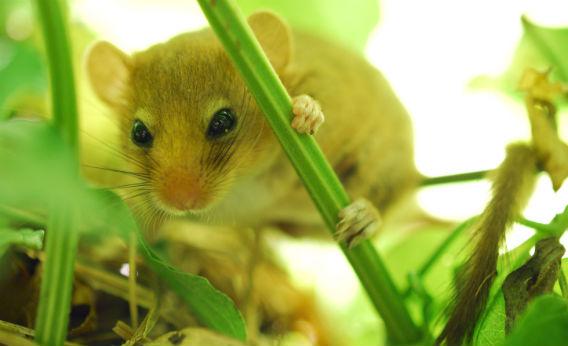A video of an adorable snoring dormouse, deep in hibernation, has gone viral this week. English dormice sleep from October to April, and animals as diverse as squirrels, lemurs, and bears all hibernate for stretches of time during the year. Do hibernating animals wake up to go to the bathroom?
Some do. All hibernating mammals have periods of arousal, which may occur weekly or monthly, depending on the animal. During these periods the animals stretch, move around, and sometimes urinate or defecate. The main purpose of hibernation is to conserve energy while food is scarce (typically during the winter months). Accordingly, animals eat and drink less during periods of hibernation, and thus expel less waste. Some hibernators, including most rodents, may peck at stored food, while others, like the Midwest’s thirteen-lined ground squirrel, store all their energy internally in the form of fat. Even those hibernators that don’t eat or drink anything at all sometimes defecate and urinate during hibernation (metabolizing stores of fat does produce waste), but these animals expel only a tiny amount during hibernation.
Hibernating bears, on the other hand, can go the whole winter without going to the bathroom. While bears are not the most serious of hibernators—they don’t sleep as deeply or lower their body temperature as many degrees as most other hibernating mammals—few animals can hold it in like bears. Many bears pass more than half of every year in hibernation, neither eating nor drinking any water. Hibernating mothers can even suckle their young without leaving their den for a drink. They obtain their water by metabolizing fat reserves, which does produce waste. However, instead of urinating and defecating, hibernating bears recycle that waste. Urea waste, which can be poisonous at high levels, is broken down to build proteins and used to maintain muscle and organ tissues during the long sleep. (While a bear may lose weight during the winter, it may also become more muscular.) The specific processes by which bears convert urea into muscle are still somewhat mysterious to researchers.
Hibernating bears develop a “fecal plug” or “tappen” in their rectum. Outdoorsmen of the 19th and early 20th century expressed curiosity about the tappen, suspecting that it might be essential to the bear’s success in retaining its sustenance during hibernation (an 1865 nature book noted that, “the tappen is very seldom cast until the animal leaves its den. In the rare instances where such an event has happened, the Bear is said to have become miserably thin and weak”). But contemporary experts differ on whether the tappen is important for plugging the rectum or whether it’s simply an unfortunate side-effect of hibernation. Northern bears, which may hibernate for as long as seven months, form extra-large fecal plugs, but all bears eventually expel the tappen outside their den in the spring. (Scientists seem not to have determined whether this process might be uncomfortable for the bear.) The North American Bear Center notes that tappens have “a light odor that is not unpleasant.”
Bears aren’t the only animals that can go all winter without a bathroom break. Some reptiles enter a hibernation-like state called “brumation,” in which they, too, slow their metabolism and let their body temperature drop. Reptiles don’t undergo the periods of arousal that most mammals do, and some frogs and turtle hatchlings have even passed much of the winter frozen solid before leaping and crawling about in the spring. If hibernation were induced in humans, as has been proposed for long-distance space travel, it’s likely that we’d have to get up once in a while to use the restroom.
Got a question about today’s news? Ask the Explainer.
Explainer thanks Brian Barnes of the University of Alaska Fairbanks and Hannah Carey of the University of Wisconsin-Madison.
